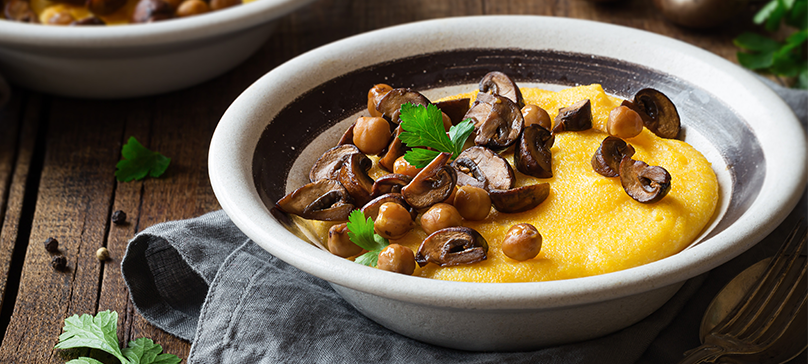Looking to satisfying your comfort food cravings? Instead of reaching for the pasta, consider a just as versatile yet more nutritious alternative by whipping up a creamy batch of polenta. You’ve probably seen it on the menu at your favorite Italian restaurant, but is polenta healthy and how do you cook it? There’s a lot to learn about this better-for-you ingredient, so let’s get started.
What is polenta?
Polenta is a classic Italian comfort dish made from boiled cornmeal. It can be served as a hot porridge or you can let it cool into a solid state, then slice, bake, fry or grill it into a fascinating array of tasty dishes. Thanks to its versatility, polenta can be used to create something for everyone’s taste.
Are grits the same as polenta?
Since they have a similar look and texture, polenta and grits are often mistaken for each other, but they certainly have some noteworthy differences. Classic polenta is made with flint corn, which originated from Italy, whereas grits are made from dent corn which is from the United States. Flint corn is heartier and less starchy than dent corn, which results in a coarser yet still delicious product.
Is polenta nutritious?
With the popularity of gluten-free eating on the rise, even non-gluten-free folks are reaching for alternatives, giving grains like corn a seat at the table. Here are some polenta nutrition facts to get you familiar with this option: ½ cup of cooked polenta offers just 100 calories, 0g fat, 22g carbs, 1g fiber and 2g protein. The cornmeal from which polenta is composed also offers the electrolyte magnesium, as well as vitamins B1, B6 and B9, which are vital for many of the body’s daily functions. Polenta’s health benefits make it a smart grain choice for your next meal, snack or even dessert.
How to make polenta:
- Boil 4 cups of water or stock.
- Whisk in 1 cup of cornmeal and 1 teaspoon salt; continue whisking 2 minutes.
- Continue cooking 40 minutes, until smooth, stirring occasionally to prevent sticking or clumping.
- Any number of seasonings and flavor enhancers can be whisked in! Salt, pepper and cheese are common add-ins.
Polenta can be enjoyed similarly to grits – topped with a variety of meats or vegetables – or formed into a loaf then used for endless dishes. To make a loaf, spread cooked polenta evenly into a loaf pan or flat on a rimmed sheet pan and cool in the refrigerator for two hours. Once cooled, the polenta is easily sliced and can be fried as a crispy appetizer to be dipped into marinara, baked or fried for croutons, used as a pizza crust or made into cakes (similar to Columbian arepas) which can be topped with meats, vegetables and sauces.
Polenta recipes
Polenta is savory and delicious in its classic hot cereal form, but don’t underestimate this comfort food – it can be transformed into a surprising array of dishes. Try a simple polenta or get adventurous with one of these tasty possibilities:
- Skillet Polenta Pizza: Brimming with classic Italian flavors, this pizza is a great game-night meal.
- Italian Sausage Polenta Lasagna: Here’s a delicious and better-for-you twist on a comfort food classic.
- Apple Salad with Parmesan Polenta Croutons: Precooked polenta croutons bring an unconventional crunch to this fresh and delicious salad recipe.
- Fresh Corn Polenta with Vegetables: Polenta, a corn-based dish similar to grits, makes a creamy, buttery base for fresh, flavorful veggies in this dish. Instead of packaged polenta, learn to make it from scratch with fresh corn!
- Beef & Ale Short Ribs with Polenta: Instantly irresistible.
For more everyday cooking inspiration, check out our full recipe collection. Explore more nutrition advice at our Health page.
Disclaimer: This information is for educational purposes only and not intended to provide healthcare recommendations. For concerns, please see a healthcare provider.

